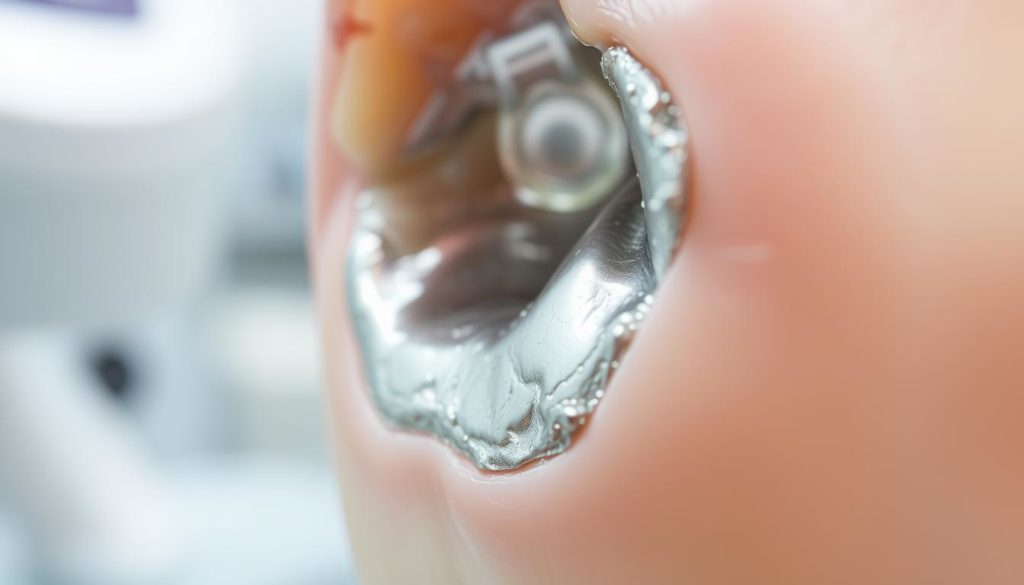Did you know that 92% of adults aged 20 to 64 have had cavities in their permanent teeth? Dental restorations like tooth fillings are important for oral health.
Choosing the right type of filling for cavities is key. We will guide you through the options, costs, and care of tooth fillings. Whether it’s amalgam, composite, ceramic, or gold fillings, you’ll find helpful tips here. Let’s dive in and learn together!
What Are Tooth Fillings and Why Are They Needed?
Tooth fillings help keep our teeth healthy by fixing damage from decay. They play a big part in treating tooth decay, making sure the tooth works right again. It’s key to know about tooth decay and the role of fillings for good dental health.
Understanding Tooth Decay
Tooth decay happens when mouth bacteria create acids that wear down tooth enamel and dentin. This can lead to cavities, causing pain, infection, and possibly loss of the tooth if not treated. Treating a cavity often means taking out the decayed part of the tooth and putting in a filling. This stops more decay by keeping bacteria out.

The Importance of Dental Fillings
Dental fillings are super important in fighting cavities. They act like a shield against bacteria and bring back the tooth’s normal use. Fillings keep our mouths healthy by stopping decay from spreading to other teeth. This helps save the natural structure of our teeth.
Without quick treatment, cavities can get worse, leading to big dental problems like abscesses. These issues might need treatments like root canals or even tooth removal. So, fillings do a lot more than fix teeth—they help keep our whole mouth healthy for a long time.
Types of Tooth Fillings
Choosing the right filling for your teeth is important. There are various types with different benefits, like durability and looks. We’ll look at four main kinds: amalgam fillings, composite fillings, ceramic fillings, and gold fillings. Knowing about each can help you decide wisely.
Amalgam Fillings
Amalgam fillings are a mix of metals like silver, mercury, tin, and copper. They’re strong and last longer than others, making them great for back teeth. Yet, their silver color might not look good in the front.

Composite Fillings
Composite fillings match your teeth’s color, making them hard to notice. They’re perfect for teeth that show when you smile. These fillings bond well with the tooth, but they’re not as strong as amalgam. Still, they work well for smaller repairs.
Ceramic Fillings
Known as inlays or onlays, ceramic fillings are made from porcelain. They look very natural and resist stains well. These fillings are great if you want something that lasts and looks good. They’re an excellent choice for those who care about looks and durability.
Gold Fillings
Gold fillings are known for lasting a long time and being very strong. They’re made from a gold alloy and handle chewing well. While more expensive, they can last decades. However, their gold color may not appeal to everyone.
| Filling Material | Durability | Aesthetics | Best For |
|---|---|---|---|
| Amalgam Fillings | High | Low | Back Teeth |
| Composite Fillings | Medium | High | Front Teeth |
| Ceramic Fillings | High | Very High | All Teeth |
| Gold Fillings | Very High | Medium | Back Teeth |
Factors Influencing the Cost of Tooth Fillings
Understanding the cost of tooth fillings means looking at several things. You need to consider the filling material, how complex the procedure is, dental insurance, and where you live. This section will help you understand these factors to plan for affordable dental care.
Type of Filling Material: Your choice of material—amalgam, composite, ceramic, or gold—affects the cost. Each one has a different look and lifespan, which influences the price.
Procedure Complexity: How deep and big the cavity is, plus its location, affects complexity. More complex fillings cost more.
Role of Dental Insurance: Your insurance might cover part of the filling cost. Checking what your insurance includes is important for saving money. Make sure to know if your plan pays for fillings and how much.
Geographic Location: Where your dentist is located also matters. Dental offices in cities usually charge more than those in rural areas.
| Material Type | Average Cost (USD) | Longevity |
|---|---|---|
| Amalgam | $50 – $150 | 10-15 years |
| Composite | $90 – $250 | 5-7 years |
| Ceramic | $250 – $4,500 | 15 years |
| Gold | $250 – $4,500 | 20+ years |
Knowing these details helps you work through dental insurance options and choose affordable care. Always talk to your dentist for advice that fits your needs.
Dental Fillings: The Procedure
Understanding what happens during a filling can make you less worried about going to the dentist. We’ll talk about everything – from your first visit to taking care of your tooth after. This way, you’ll know exactly what to expect.
Initial Consultation and Prepping
Your dental visit starts with a chat about your teeth. The dentist will check your teeth. They might also take X-rays to find any cavities clearly. After that, they’ll tell you what needs to be done next.
Then, they get the tooth ready. They’ll use something to numb the area. This means you won’t feel pain during the procedure.
The Filling Process Explained
With the area ready, the dentist takes out the decayed part of the tooth. They might use a drill, laser, or another tool. Then, they clean the cavity well, getting rid of germs and dirt.
The filling starts next. If it’s a composite filling, they use a special light to set it. After the filling is in, they shape and polish it. Now, it looks just like part of your tooth.
Post-Procedure Care
After the filling, taking care of your tooth is key. You might feel your tooth is sensitive at first, but this should stop after a few days. Don’t eat or drink things that are too hot or cold right after your visit. Keep your teeth clean by brushing and flossing well. Also, see your dentist often. They can check on your filling and make sure your teeth are healthy.
| Step | Description | Tips |
|---|---|---|
| Initial Consultation | Examining and identifying the decay | Ask questions about the procedure |
| Prepping | Numbing and cleaning the tooth | Relax and trust the anesthetic |
| Filling Procedure | Filling the cavity and shaping the tooth | Follow post-procedure care tips |
| Post-Procedure Care | Maintaining oral hygiene and avoiding sensitivity | Stick to a soft diet initially |
The Pros and Cons of Composite Fillings
Composite fillings, also known as aesthetic dental fillings, match your natural teeth well. They are liked by many for their looks.
- Aesthetic Appeal: These fillings can be made to look just like your real teeth. They look better than other filling types.
- Bond Strength: They bond well to your tooth. This helps support the tooth and stops it from breaking.
- Versatility: You can use them to fix teeth that are chipped, broken, or worn down. They also fill cavities.
Cons of Composite Fillings
- Durability Issues: They may not last as long as silver fillings. You may need to replace them if you chew a lot.
- Procedure Duration: Putting them in takes more time. The dentist has to layer and cure them during the process.
- Sensitivity: After getting these fillings, your teeth might feel more sensitive. This is especially true for hot and cold temperatures.
Knowing the pros and cons of fillings is key before deciding. Composite fillings look great and bond well, but they may not last as long. Think about these facts to choose what’s best for your teeth.
The Longevity of Different Filling Materials
It’s key to know the filling lifespan and filling durability of each dental material. This helps in deciding what’s best for you. We’ll cover the life expectancy of amalgam, composite, ceramic, and gold fillings.
Average Lifespan of Amalgam Fillings
Amalgam is a mixture that includes mercury, silver, tin, and copper. It’s known for lasting a long time. You can expect an amalgam filling to last from 10 to 15 years. This makes it a durable option. Yet, the mercury in it worries some people.
Longevity of Composite Fillings
When comparing amalgam to composite, people like the look of composite fillings. They match your teeth well. But they don’t last as long as amalgam, usually around 5 to 7 years. The life of these fillings depends on their size, where they are, and your habits.
Durability of Ceramic and Gold Fillings
Ceramic fillings, typically made of porcelain, look natural and are quite durable. They can hold up for about 10 to 12 years. Gold fillings are less seen but very tough. Their lifespan exceeds 20 years, as they don’t corrode or wear easily.
| Filling Material | Average Lifespan |
|---|---|
| Amalgam | 10-15 years |
| Composite | 5-7 years |
| Ceramic | 10-12 years |
| Gold | 20+ years |
How to Care For Your Tooth Fillings
Proper care for tooth fillings helps them last longer and keeps your mouth healthy. Let’s look at good dental habits, what to avoid eating, and why check-ups are important.
Routine Dental Hygiene
Good dental hygiene keeps your fillings in great shape. Brush twice daily with fluoride toothpaste. Floss every day to clean where your brush can’t. Also, using antibacterial mouthwash fights bacteria, protecting your fillings.
Foods and Habits to Avoid
Some foods and habits can hurt your fillings. Don’t eat hard or sticky foods like candy and nuts. They can pull out or harm your fillings. Also, cut down on sugary drinks and acids that cause decay.
Don’t use your teeth to open things or bite your nails. It puts too much pressure on your fillings.
Regular Dental Check-Ups
Seeing your dentist often is key to keeping fillings and teeth healthy. They can check your fillings for wear or damage. They also clean your teeth well to keep your mouth healthy.
Regular visits help catch and fix problems early. This can save your fillings from breaking too soon.
Signs That You May Need a Dental Filling
Dental health often drops hints before a big issue comes up. It’s key to catch these early signs of cavities and the need for a filling. Let’s talk about what to look out for:
- Tooth Pain or Sensitivity: Pain or sensitivity to hot, cold, or sweet stuff means you might need a filling. This shows that the tooth’s outer layer is damaged.
- Visible Holes or Dark Spots: Seeing holes or dark areas on your teeth points to cavities. They can get worse if not fixed.
- Bad Breath or Unpleasant Taste: Ongoing bad breath or a nasty taste could mean decay. This could show you need a filling to solve the problem.
- Flossing Rips: If floss breaks or shreds between some teeth, it might be due to cavities. This can signal a need for a filling.
Spotting these signs early is crucial for oral health. Dealing with them quickly can avoid bigger treatments and keep teeth healthy.
| Symptom | Possible Indication |
|---|---|
| Tooth Pain | Compromised enamel, might be a cavity |
| Visible Holes | Cavities that need quick care |
| Bad Breath | Could be decay or an infection |
| Floss Rips | Possible cavities or uneven edges |
Watch for these warning signs. Find any? See your dentist to see if you need a filling. Catching it early can really help your teeth stay strong and healthy.
Tooth Fillings for Children
Pediatric dentistry has unique needs, especially with child tooth fillings. Making sure dental care for kids is effective and comfortable is key. We’ll look at some top concerns parents have and the child-friendly filling materials that address these issues.
Common Concerns
Parents are often worried about the pain their child might feel during a filling. Luckily, modern pediatric dentistry uses methods to reduce discomfort. Another big worry is about the safety and durability of filling materials. Parents need to know these materials are safe and will last a long time.
Child-Friendly Filling Materials
Various materials are used in kids’ dental care that are both safe and effective:
- Composite Resin: This material matches the natural tooth color, making fillings less visible. It’s strong and bonds well to the tooth.
- Glass Ionomer: It releases fluoride, which prevents more decay. This makes it great for fillings in baby teeth.
- Resin Ionomer: This is a mix of composite resin and glass ionomer. It offers strength and decay prevention.
Metal-Free Fillings: An Overview
People prefer metal-free dentistry today for its looks and for being allergy-friendly. Now, you can pick from resin or ceramic fillings. Each kind brings its own perks.
Resin fillings match your tooth color well, perfect for teeth that show when you smile. They are kind to your tooth, needing less drilling.
Ceramic fillings, on the other hand, are tough and don’t stain easily. They last longer. Even though they cost more, their strength and longevity make them worth it for those looking for a lasting fix.
Here’s how resin and ceramic fillings stack up:
| Characteristic | Resin Fillings | Ceramic Fillings |
|---|---|---|
| Aesthetics | Excellent | Very Good |
| Durability | Moderate | High |
| Stain Resistance | Moderate | High |
| Cost | Affordable | Expensive |
To sum up, both resin and ceramic fillings are great choices. They look better and are safer than metal options. Your decision might hinge on what matters more to you: cost, looks, or strength.
Tooth Restoration Beyond Fillings
Traditional fillings work well for cavities, but there are better options. Dental inlays, onlays, crowns, and veneers offer more. They last longer and look better. Exploring these choices helps people decide how to fix their teeth.
Inlays and Onlays
Dental inlays and onlays are like partial crowns. They fix teeth with moderate decay. Inlays fit inside the tooth’s cusps, and onlays cover them. They are made of porcelain, composite resin, or gold. The choice depends on what the patient likes and the dentist’s advice.
Crowns and Veneers
Crowns and veneers improve your teeth’s look and function. Crowns cover and protect damaged teeth. They help with cracked or worn teeth, especially after a root canal. Veneers are thin pieces that cover the tooth’s front. They fix discoloration, small gaps, or chips.
Knowing about all tooth restoration options is helpful. It lets people take better care of their teeth. Always talk to a dentist about what’s best for your teeth.
FAQ
What are tooth fillings and why are they needed?
Tooth fillings restore a tooth damaged by decay. They fill cavities to prevent more damage. This helps keep your teeth healthy.
What types of tooth fillings are available?
There are many tooth filling types. These include amalgam, composite, ceramic, and gold fillings. Each has pros and cons like cost and look.
How much do tooth fillings cost?
The price of tooth fillings depends on the material, the procedure’s complexity, and where you live. Insurance may affect the cost too. Prices range from to 0 for each filling.
What happens during a tooth filling procedure?
The dentist will consult, clean the tooth, remove decay, and then fill it. They shape and polish the filling to finish.
What are composite fillings?
Composite fillings are tooth-colored, blending with your natural teeth. They’re made of plastic and glass. But they may not last as long as metal fillings.
How long do different filling materials last?
Fillings have different lifespans. Amalgam lasts about 10-15 years. Composite lasts 5-7 years. Ceramic and gold fillings can last over 15 years with care.
How should I care for my tooth fillings?
Take care of your fillings by brushing, flossing, and avoiding hard foods. Regular dental check-ups are also important.
What are the signs that I may need a dental filling?
If you have tooth pain, sensitivity, see holes, or have pain when you bite, you may need a filling. Visit a dentist if you notice these signs.
Are there special considerations for tooth fillings in children?
Yes. Kids’ fillings use materials and techniques suited for them. Pediatric dentists aim to make the process easy for children.
What are metal-free fillings?
Metal-free fillings like resin and ceramic are for those avoiding metal. They look better and are less likely to cause allergies.
What options exist for tooth restoration beyond fillings?
Other options include inlays, onlays, crowns, and veneers. These can fix teeth that fillings can’t, improving their function and look.


